重大版小学英语4年级下册unit1 语法点和习题
重大版小学4年级下英语
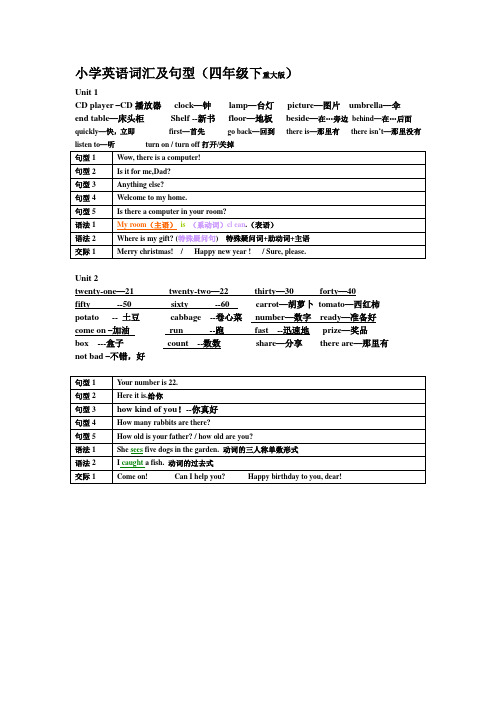
小学英语词汇及句型(四年级下重大版)Unit 1CD player –CD播放器clock—钟lamp—台灯picture—图片umbrella—伞end table—床头柜Shelf --新书floor—地板beside—在…旁边behind—在…后面quickly—快,立即first—首先go back—回到there is—那里有there isn’t—那里没有listen to—听turn on / turn off打开/关掉Unit 2twenty-one—21 twenty-two—22 thirty—30 forty—40fifty --50 sixty --60 carrot—胡萝卜tomato—西红柿potato -- 土豆cabbage --卷心菜number—数字ready—准备好come on –加油run --跑fast --迅速地prize—奖品box ---盒子count --数数share—分享there are—那里有not bad –不错,好Unit 3breakfast—早餐lunch—午餐dinner—正餐,晚餐get up—起床go to school—上学go home—回家go to bed—睡觉in the morning—在早上in the afternoon—在下午in the evening—在晚上at night—在夜里time—时间o’clock--**点钟sleepy—想睡觉的minute—分钟more—更多的show—表演 A.M.—上午前P.M.—下午后football—足球basketball—篮球tennis—网球ping pong—乒乓球cycling—骑自行车swimming—游泳hiking—徒步旅行skiing—滑雪pass the ball—传球kick the ball—踢球play ping pong—打乒乓easy—容易的learn—学习show –展示superb—极好的goal—得分Unit 5rainy—下雨的cloudy—多云的snowy—下雪的sunny—有阳光的windy—有风的warm—暖和的hot-- 热的,烫的cool –凉爽的cold—寒冷的wet –潮湿的how –怎么样today –今天can –可以can’t –不可以what about –怎么样go cycling –去骑车Unit 6Seal –海豹shark –鲨鱼turtle –海龟whale –鲸Dolphin –海豚penguin –企鹅crab –螃蟹sea lion –海狮Toilet –厕所in front of –在^前面between—在…中间sea –海洋Favourite –特喜欢的cute—机灵可爱的clever—聪明的sing –唱歌Dance –跳舞lucky –幸运的over there –那里come on –赶紧。
【四年级】重大版英语四年级下册Unit1WhereismypencilboxLesson1练习题

【关键字】四年级Unit 1 Where is my pencil box?Lesson 1习题一. 写出下列介词的中文意思。
on inunder near二. 选择填空1. ______ your hat?A. WhereB. Where'reC. Where's2. Is his pencil box ____ the drawer?A. inB. atC. behind3. The CDs ______ in the drawer.A. amB. isC. are4. I have an alarm clock. It's ____ the box and the computer.A. betweenB. behindC. under5. —Are the shoes under your bed?—_________.A. Yes, it isB. Yes, they areC. No, it isn't三.将单词按正确的顺序排列。
derun_____ wereh_____ penilc____naer_____ dske_____ cihar____四.根据汉语意思完成英语句子1. “书包在哪儿?”“在桌子下面。
”—_________ the schoolbag?—It's ________ the table.2. “地图在哪儿?”“我认为在你爷爷奶奶的房间。
”— ________ the map?—I think it's _____ your ________________room.3. “你的书在哪儿?”“它们在椅子上。
”—________ _______ your books?—They are ______ the chair.4. 钥匙在书架上。
The keys _______ _______ the bookcase.五. 句型转换。
四年级英语下册Unit1知识点复习练习及答案

四年级英语下册Unit1知识点复习练习及答案Nothing is impossible for a willing heart.心之所愿,无所不成。
下面是小编为你整理的有关的停雨复习资料,希望能帮到你!单词look like 看起来像......which [wɪtʃ] 哪一个;哪一些with [wɪð] 有;和...在一起glasses ['glɑ:sɪz] 眼镜her [hə(r)]她(she的宾格)know [nəʊ]知道him [hɪm] 他(he的宾格)policewoman [pəˈli:swʊmən] 女警察policewomen [pə'li:swɪmɪn] 女警察(复数)uniform [ˈju:nɪfɔ:m] 制服its [ɪts] 它的their [ðeə(r)] 他(她、它)们的Unit1 课文与翻译Unit 1 He looks like a cookWho’s that woman?Which woman?The one with glasses. She has a bag beside her.She’s Miss Liu, our teacher.And that man in a white hat? Can you see him?Yes. But I don’t know him. He looks like a cook.那个女人是谁?哪个女人?带眼镜的那个。
她身边有一个书包。
她是刘小姐,我们的老师。
那个戴白帽子的人?你能看见他吗?对。
但我不认识他。
他看起来像个厨师。
重点内容与习题【知识考点一】介词in的用法:1) in 后面加上“衣帽”类单词,表示“穿(戴)着……”。
如:In a blue coat 穿着蓝色外套in a red cap 戴着红色棒球帽2)in 后面加“位置”类单词,表示“在……里面”。
如:The books are in my desk. 这些书在我的书桌里。
四下Unit1知识点总结
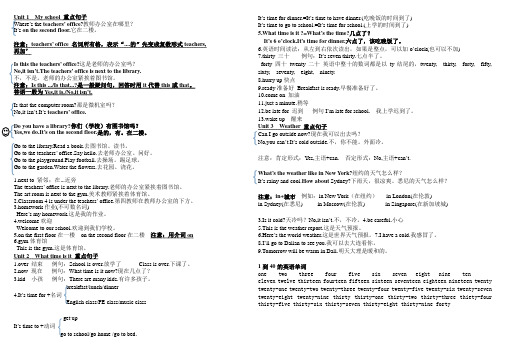
Unit 1 My school 重点句子 Where’s the teachers ’ office ?教师办公室在哪里?It ’s on the second floor.它在二楼。
注意:teachers ’ office 名词所有格,表示“....的”先变成复数形式teachers,再加’Is this the teachers ’ office?这是老师的办公室吗? No,it isn ’t.The teachers ’ office is next to the library.不,不是。
老师的办公室紧挨着图书馆。
注意:Is this .../Is that...?是一般疑问句,回答时用it 代替this 或that 。
答语一般为Yes,it is./No,it isn ’t.Is that the computer room?那是微机室吗?No,it isn ’t.It ’s teachers ’ office.Do you have a library?你们(学校)有图书馆吗?Yes,we do.It ’s on the second floor.是的,有。
在二楼。
Go to the library.Read a book.去图书馆。
读书。
Go to the teachers ’ office.Say hello.去老师办公室。
问好。
Go to the playground.Play football.去操场。
踢足球。
Go to the garden.Water the flowers.去花园。
浇花。
1.next to 紧邻;在...近旁The teachers ’ office is next to the library.老师的办公室紧挨着图书馆。
The art room is next to the gym.美术教师紧挨着体育馆。
2.Classroom 4 is under the teachers ’ office.第四教师在教师办公室的下方。
三年级起点 小学四年级下 Unit1 知识汇总及配套练习
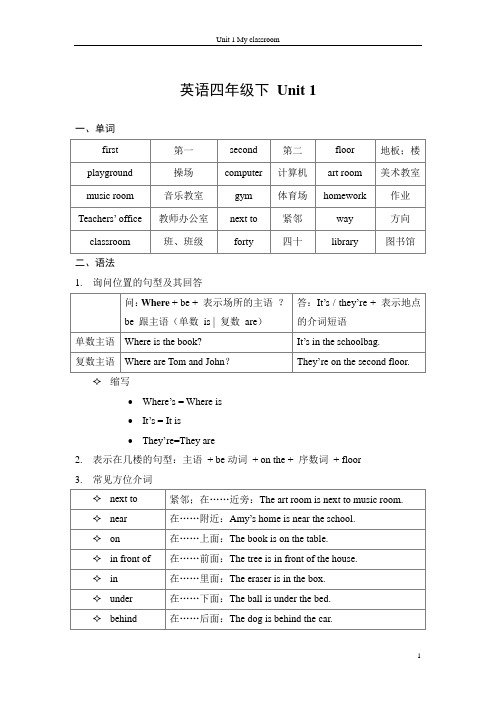
英语四年级下Unit 1一、单词二、语法1.询问位置的句型及其回答✧缩写∙Where’s = Where is∙It’s = It is∙They’re=They are2.表示在几楼的句型:主语+ be动词+ on the + 序数词+ floor3.常见方位介词4.基数词& 序数词5.确认事物的句型及其答案6.say…to sb:向某人……7.play的用法✧play+球类:play basketball;play volleyball✧play+ the+乐器:play the piano;play the guitar;play the violin8.water的用法✧动词:给……浇水【water the flowers.】✧名词:水【I would like a cup of water】9. 发音[ə]——er(1) sist er rul er und er numb er (2) comput er eras er dinn er winter (3) und er aft er wat er riv er10. 询问对方是否有某物的句型及其回答 11. 指引别人走路的句型:[Go / Walk] this way ,please .——请这边走。
12. 介绍自己的学校13. 限定名词的方式✧ This is the way I go to school, where I like to learn all day. ✧ This is the classroom in my school, where I like to learn all day.三、相关练习1.单词2.句型(1)教师办公室在哪里?______________________________(2)它在二楼。
______________________________(3)你们(学校)有图书馆吗?______________________________(4)是的,有。
202X年Pep四年级英语下册unit1知识点及练习
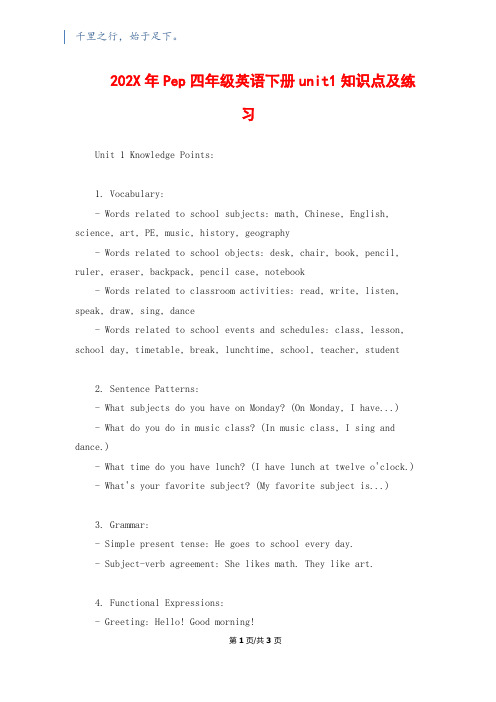
千里之行,始于足下。
202X年Pep四年级英语下册unit1知识点及练习Unit 1 Knowledge Points:1. Vocabulary:- Words related to school subjects: math, Chinese, English, science, art, PE, music, history, geography- Words related to school objects: desk, chair, book, pencil, ruler, eraser, backpack, pencil case, notebook- Words related to classroom activities: read, write, listen, speak, draw, sing, dance- Words related to school events and schedules: class, lesson, school day, timetable, break, lunchtime, school, teacher, student2. Sentence Patterns:- What subjects do you have on Monday? (On Monday, I have...)- What do you do in music class? (In music class, I sing and dance.)- What time do you have lunch? (I have lunch at twelve o'clock.) - What's your favorite subject? (My favorite subject is...)3. Grammar:- Simple present tense: He goes to school every day.- Subject-verb agreement: She likes math. They like art.4. Functional Expressions:- Greeting: Hello! Good morning!第1页/共3页锲而不舍,金石可镂。
(部编)统编版四年级英语下册第一单元知识小结

(部编)统编版四年级英语下册第一单元知
识小结
本单元的研究内容主要包括以下几个方面:
一、重点短语
研究园地、北极熊、国庆节、中秋节、地球、世界、旅游车、动物园、照相机、冰淇淋、回家
二、语法要点
1. 现在进行时:
am/is/are + doing
如:I am playing football.
2. 物主代词:
my、your、his、her、its、our、their
如:This is my book.
3. 一般疑问句:
用动词的原形在句首 + 主语
如:Are you running?
4. 选择疑问句:
用疑问代词在句首 + be/am/is/are + 主语 + 动词原形如:What are you doing?
三、听力技巧
1. 注意听力语境,理解对话全貌。
2. 重点听取关键词。
3. 注意听取时间、地点、人物等信息。
4. 如果听不懂,可以请老师或同学帮忙。
四、研究策略
1. 多听、多读、多说、多写。
2. 培养良好的研究惯,经常复课堂内容。
3. 积极参与课堂讨论和活动,提高口语表达能力。
4. 利用多媒体工具和网络资源加强研究效果。
通过学习,我们不仅能掌握相关的语言表达技巧,还能了解到
丰富的知识和文化内涵。
希望同学们能够在学习中获得快乐和进步!。
重大版小学英语四年级下册教(学)案(Unit 1)

重大版小学英语四年级下册教(学)案(Unit 1)Unit 1 Where Is My Pencil Box? 我的铅笔盒在哪里Lesson 1 第一课1.Look, listen and say(看,听,说)Hao Tian:Gee, that’s funny. 哎呀,真有趣。
Where is my pencil box?我的铅笔盒在哪里?Lu Hua:Is it in your desk?它在你的书桌你吗?Hao Tian:No, it isn’t here.不,它不在这儿。
Du Xiaomao:Look, it’s on my desk.瞧,它在我的书桌上。
Hao Tian:Uh-oh!喔/呃/ 噢/ 啊哦!Du Xiaomao:Here you are.给你。
Hao Tian:Thanks a lot.非常感谢。
Max: Where are the crayons?我的蜡笔在哪里?Rex: They’re on the chair.它们在椅子上。
2.Listen and link听音连线/匹配( )①chair椅子( )②desk书桌( )③chair椅子( )④desk书桌( )⑤deskA.car小汽车B.pencil box铅笔盒C.book书桌 B.basketball篮球D.toy玩具3.Let’s practise让我们一起练习吧Mr. White:Where is the train?火车在哪里?Gao Wendi:It’s on the chair.它在椅子上。
Mr. White:Where is the chair?椅子在哪里?Du Xiaomao:It’s near the desk.它在书桌附近。
Mr. White:Where are the rulers?直尺在哪里?Hao Tian:They’re in the pencil box.它在铅笔盒里。
5.Let’s play a game让我们一起做游戏Steps步骤:1)Cover one’s eyes蒙住某人的眼睛2)Hide a ruler把一块直尺藏起来3)Everyone shouts每个人大声问,“Where is the ruler?”直尺在哪里?Gao Wendi, Du Xiaomao and Hao Tian:“Where is the ruler?”直尺在哪里?Student 1:“Where is the ruler?”直尺在哪里?Under the desk?在书桌下面吗?Hao Tian:No.不。
重大版小学英语四年级下册知识点汇总

Unit 1 Where is my pencil box ?重点词汇:on 在......上面in 在.......里面under 在......下面near 在......附近pencil box铅笔盒where在哪里on the desk 在书桌上面in the desk 在书桌里面under the chair 在书桌下面near the chair 在椅子附近blackboard 黑板fan 风扇map 地图schoolbag 书包light 灯where 在哪里they 它们重点句型:1.---Where is my pencil box ? 我的铅笔盒在哪里?---It’s on / in / under / near the _______.它在......上面/里面/下面/附近。
例句:---Where is the fan? ---It’s on the desk.---Where is the light? ---It’s near the desk.---Where are the pencils? ---They’re under the chair.---Where are the pens? ---They’re in the pencil box.2.---Where are the crayons? 蜡笔在哪里?---They’re on / in / under / near the _______.它们在......上面/里面/下面/附近。
例:---Where is the hen ? ---It is in the grass.---Where is the horse ? ---It is near the pig.---Where are the birds ? ---They are on the cow.---Where are the sheep ? ---They are under the tree.3.---Is it ... ? 它在......吗?---Yes, it is.(是的,它在。
四年级下册英语一单元重点知识
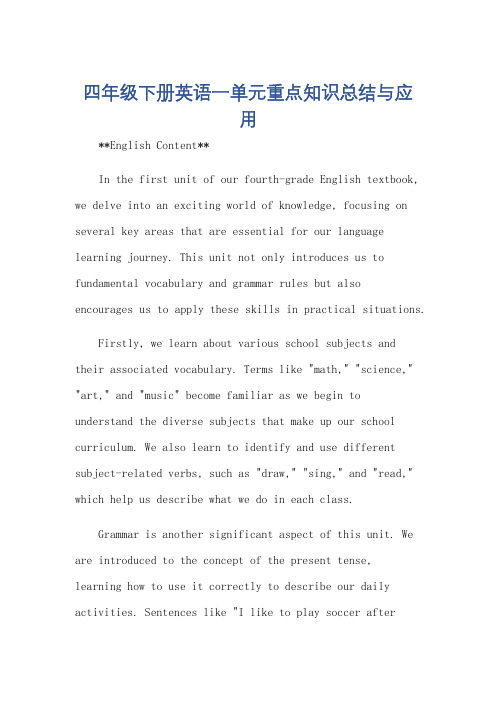
四年级下册英语一单元重点知识总结与应用**English Content**In the first unit of our fourth-grade English textbook, we delve into an exciting world of knowledge, focusing on several key areas that are essential for our language learning journey. This unit not only introduces us to fundamental vocabulary and grammar rules but also encourages us to apply these skills in practical situations. Firstly, we learn about various school subjects andtheir associated vocabulary. Terms like "math," "science," "art," and "music" become familiar as we begin tounderstand the diverse subjects that make up our school curriculum. We also learn to identify and use different subject-related verbs, such as "draw," "sing," and "read," which help us describe what we do in each class.Grammar is another significant aspect of this unit. We are introduced to the concept of the present tense,learning how to use it correctly to describe our daily activities. Sentences like "I like to play soccer afterschool" and "She reads books every evening" help us grasp the structure and usage of the present tense.Moreover, the unit emphasizes the importance of functional language. We learn how to express our likes and dislikes, opinions, and routines using phrases like "I like..." and "I don't like..." This functional language not only improves our conversational skills but also makes us more confident in expressing ourselves in English.Practical application is a crucial part of this unit. Through various activities and exercises, we are encouraged to apply the knowledge we have learned. Role-playing games allow us to practice speaking in English about our favorite subjects and activities. We also engage in writing tasks, such as describing our daily routines or expressing our opinions on different subjects.Finally, the unit concludes with a focus on cultural aspects related to school life. We learn about different school systems and traditions from around the world, expanding our understanding of the diverse educational environments that exist.Overall, the first unit of our fourth-grade English textbook provides a solid foundation for our language learning, equipping us with the essential vocabulary, grammar rules, and functional language necessary for effective communication. Through practical application and cultural exploration, we not only improve our English skills but also gain a deeper understanding of the world around us.**中文内容**在四年级下册英语的第一单元中,我们深入探索了一个充满知识的世界,重点掌握了几项对我们语言学习之旅至关重要的内容。
第一单元《 Where is my pencil box》大单元教案-四年级英语下册(重大版)

单元目标:Unit 1 Where is my pencil box?1.会听说和认读本单元重点单词和词组:blackboard、fan、map、schoolbag、light、on the desk、in the desk、under the chair、near the chair。
2. 学会运用句型:where is/are…?对事物所在的位置进行提问,并能用句型:it’s/they’re in/on/under…作答。
3.掌握介词“in/on/under/near”的用法,并能在日常生活中灵活运用。
4.了解并掌握祈使句的日常交际用语。
5.学习和掌握元音字母“a”在单词中的读法规则。
6.简单了解元宵节,并会用“the lantern festival”来表达元宵节。
am , and ,fan, bag, blackboard, map. hand2.请学生给出答案:这些单词都有字母a, 它的发音都是[æ]。
3.试着拼读单词:[æ] an, at, ake, ate cat, rat, hat, bad, Dad, cap.设计意图教师以故意犯错的方式让学生自己发现问题,更利于学生纠正错误。
注重书写规范性和笔划顺序可以培养学生正确的书写习惯。
Step3 Cooperative learning (合作交流,共同探究)小组合作:1.W here is/are the…? It’s/They’re….:2.What can you see? I can see … on/in/….设计意图让学生合作交流,复习所学知识,帮助他们熟练掌握和灵活运用所学知识进行综合实践。
Step4 Practice and Assessment (达成任务,互助展评)1、Play the radio of part 1&2. Let the Ss listen number and finish part 1&2.2.Let the Ss finish part4: Look,read and write.。
重大版四年级下册英语有效教学学案

重大版四年级下册英语有效教学学案Unit 1 Lesson 1一.学习目标1. 会听.说.读本课时的主要单词:on the desk in the desk under the chair near the chair t2. 会听.说:Where is my pencil box ? Is it in your desk ? No , it isn’t here .二.学习过程1. 复习a. 英汉互译:pen pencil ruler crayonb. Let’s chant : What is it ? It’s a pen .What is it ? It’s a pencil .Where is it ? It’s a crayon .2. 尝试学习题a. 看图片.听录音模仿读新词。
b. 师生大小声练读新单词。
c. 看图片说单词.看单词说词义。
3. 巩固练习题a. 抄写新学单词。
b. 听录音模仿读对话。
c. 理解对话.提出主句型讲解。
d. 教读对话。
3. 巩固练习题(1). 同桌互相交换提问:A: Where is my pencil box .B: Is it in your desk ? No , it isn’t here .(2). 听录音为你听到的句子编号。
4. 总结归纳强调where 的语用功能.区分are , is 的用法。
三.当堂检测1.写出单词的中文意思On the desk ( ) in the desk ( ) under the chair ( )near the chair ( )2.选择题()______ is my pencil ?A. WhatB. WhereC. Who( ) Is it ____ your desk ?A. onB. inC. at( ) 你找你的蜡笔时你说:A .Where is my pencil ?B. Where are the crayons ?C. What is the crayon ?( ) 你告诉妈妈说它们在椅子上时说:A. It’s on the desk .B. They on the desk .C. They in the desk .Unit1 A Lesson 2一.学习目标1. 会听.说.读本课时的主要单词:blackboard fan map schoolbag light2. 会听.说,译:Please give me a hand . Pass me the maps , please . All right , Miss Liu .二.学习过程1. 复习a. 英汉互译:in the desk on the desk under the chairb. Make a chant : desk desk in the desk , my crayons are in the desk .…2. 尝试学习a. 看图片.听录音模仿读新词。
四年级语法下册练习题

四年级语法下册练习题第一单元名词的性数一、用所给名词的适当形式填空。
1. There are five ____________(box) on the table.2. Two ____________(child) are playing in the park.3. Do you have any ____________(pencil) in your pencil case?4. My father bought two ____________(knife) for the kitchen.5. There are many ____________(ox) on the farm.二、选词填空。
hands birds girls boys boxes1. The __________ are playing football in the field.2. Look! The __________ are flying in the sky.3. My mother has two __________.4. These are my sister's __________.5. Please put the __________ on the shelf.三、按要求写句子。
1. 改为单数形式:There are many books in the library.2. 改为复数形式:This is an apple.3. 换一种说法:There are two pens on the desk.第二单元形容词和副词一、选词填空。
happy slowly fast small tall1. The rabbit can run __________.2. We walked __________ to the park.3. The dog is very __________.4. The boy is __________ than his sister.5. The baby is __________.二、用所给形容词和副词的适当形式填空。
四年级下册英语第一单元知识归纳
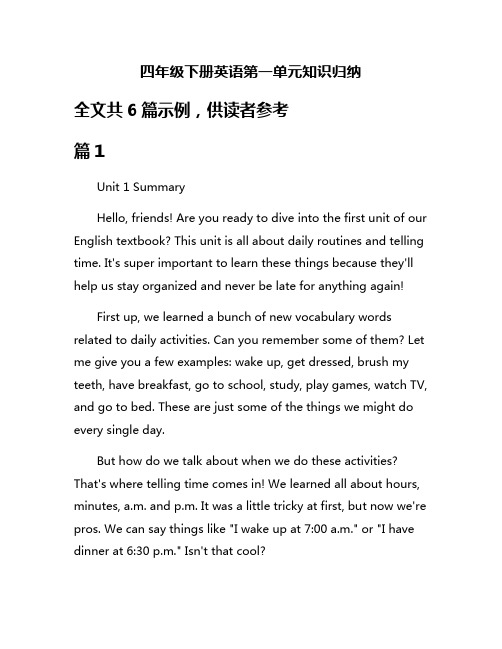
四年级下册英语第一单元知识归纳全文共6篇示例,供读者参考篇1Unit 1 SummaryHello, friends! Are you ready to dive into the first unit of our English textbook? This unit is all about daily routines and telling time. It's super important to learn these things because they'll help us stay organized and never be late for anything again!First up, we learned a bunch of new vocabulary words related to daily activities. Can you remember some of them? Let me give you a few examples: wake up, get dressed, brush my teeth, have breakfast, go to school, study, play games, watch TV, and go to bed. These are just some of the things we might do every single day.But how do we talk about when we do these activities? That's where telling time comes in! We learned all about hours, minutes, a.m. and p.m. It was a little tricky at first, but now we're pros. We can say things like "I wake up at 7:00 a.m." or "I have dinner at 6:30 p.m." Isn't that cool?One of the most useful things we practiced was asking and answering questions about daily routines. We can ask each other "What time do you get up?" or "When do you do your homework?" Knowing each other's schedules helps us make plans to hang out or study together.Do you remember the story we read about Sam's daily routine? He was a really busy kid! He woke up early, had a healthy breakfast, went to school, played soccer after school, did his homework, helped with chores, and finally got to relax before bedtime. Phew, I'm tired just thinking about it!We also learned about the days of the week and months of the year. Saying things like "I have soccer practice on Tuesdays and Thursdays" or "My birthday is in August" is super handy. Keeping track of the calendar is important for not missing any special days or events.Another cool thing we did was make schedules and timetables. We could write out our whole daily routine hour by hour, from morning to night. Or we made timetables showing our weekly activities, like when we have English class, art club, or piano lessons. Having a schedule helps us stay organized and use our time wisely.Remembering to use words like "first, next, then, and finally" was really important for talking about routines and putting things in order. Like, "First I wake up, then I get dressed, next I have breakfast, and finally I go to school." See how clearly that explains the sequence?Whoa, that was a lot to cover in one unit! We learned so many helpful vocabulary words and phrases for describing our daily lives. Things like daily routines, telling time, days and months, schedules, and sequencing are all skills we'll use over and over again.I hope this review has refreshed your memory on everything we learned. Give yourself a big pat on the back for working so hard! Mastering this unit will make the rest of the year feel like a breeze. Keep up the great work, my friends!篇2Unit 1 - All About MeThis unit was all about learning how to introduce ourselves and share information about our lives. It was really fun because we got to talk about our hobbies, families, favorites, and more!The first thing we learned were the question words - who, what, where, when, why, and how. These little words help us ask lots of different kinds of questions. Who is for asking about people, what is for asking about things, where is for asking about places, when is for asking about times, why is for asking about reasons, and how is for asking about the way something is done.Next we practiced asking and answering questions using the verb "to be." Things like "What is your name?" "My name is Amy." Or "Where are you from?" "I am from Beijing." Using "to be" properly is really important for introducing ourselves.We also learned about subject pronouns like I, you, he, she, it, we, and they. Subject pronouns are used as the subject of a sentence instead of using a name. For example, instead of saying "Amy is 10 years old," I would say "I am 10 years old."Another thing we studied were possessive adjectives like my, your, his, her, its, our, and their. These are useful for talking about the things that belong to us or others. Like "This is my schoolbag" or "Their dog is very friendly."The verb "to have" is super useful too. We can use it to talk about our belongings, family members, hobbies, and more. For example, "I have a little sister" or "David has a collection of toy cars."Speaking of hobbies, we learned a ton of vocabulary words for different activities people like to do for fun. Some examples are reading, cooking, hiking, swimming, painting, and playing sports or musical instruments. It was really interesting to learn about all the different hobbies my classmates enjoy.We also covered vocabulary for describing personalities. Words like kind, smart, funny, brave, hardworking, and more. It's nice to be able to compliment our friends and family on their great personality traits.Family vocabulary was important too. We learned words like mother, father, brother, sister, grandparents, cousins, aunts, and uncles. Using possessive adjectives with these words helps specify who we're talking about - like "my brother" or "her cousins."One of my favorite activities was sharing about our routines and schedules using frequency adverbs like always, usually, sometimes, rarely, and never. We made sentences like "I always brush my teeth before bed" or "My brother never remembers his homework."Towards the end of the unit, we put everything together and gave full self-introductions. We stated our name, age, where we're from, described our families and hobbies, and shared otherinteresting details about ourselves. It was fun to learn so much about my classmates!Overall, Unit 1 gave us a really strong foundation for basic conversation. Now we know how to greet people, introduce ourselves, ask about others, share details about our lives, and more. I feel much more confident speaking English after all we learned. Can't wait for the next unit!篇3Unit 1: My Wonderful FamilyHi there! I'm so excited to share with you what I learned in the first unit of our new English textbook. It's all about families, which is such an important topic because our families are the people who love us the most in the world!First up, we learned lots of new vocabulary words related to family members. Can you believe there are so many different words to describe the different people in our families? Here are some of the ones I remember:Mom, dad, parents, grandma, grandpa, grandmother, grandfather, aunt, uncle, cousin, sister, brother, sibling, nephew, niece, in-laws, stepmother, stepfather, stepsister, stepbrother.Whew, that's a lot of words! It's kind of confusing to keep them all straight, but my teacher says that's okay because we'll keep practicing, and soon they'll all become second nature.Next, we learned how to introduce our family members to others. It's really important to be able to do this because families are such a big part of our lives. We practiced phrases like:"This is my mom, her name is...""These are my grandparents, they are...""That's my little brother, his name means..."We also talked about different types of families and how every family is unique and special. Some kids live with just one parent, some live with grandparents or other relatives, and some have two moms or two dads. But no matter what a family looks like, the most important thing is that there is love.My favorite part was when we learned about family traditions and customs from around the world. Did you know that in some countries, extended families with grandparents, aunts, uncles, and cousins all live together in one big house? In other places, it's traditional for the youngest child to care for their elderly parents. We even learned about some unique coming-of-age ceremonies that mark the transition from child toadult in different cultures. Learning about all these fascinating traditions really opened my eyes to how diverse the world is!We read some wonderful stories about families overcoming obstacles, helping each other out, and making wonderful memories. My personal favorite was the one about the family who went camping for the first time and got caught in a huge thunderstorm – but instead of being scared, they all started dancing and singing in the rain! What a funny and joyful way to make the best of a difficult situation.To wrap up the unit, we talked about different ways to show our love and appreciation for our families. We brainstormed ideas like writing thank-you notes, cooking a special meal, giving hugs, spending quality time together, and simply telling our family members how much they mean to us. Because at the end of the day, that's what families are all about – surrounding ourselves with people who care about us unconditionally.I have to say, this unit was so much fun and really made me appreciate my own wonderful family even more. I can't wait to put what I learned into practice and strengthen those loving bonds. Families truly are the greatest gift!篇4Unit 1 Topic: My DayHi friends! In our first unit this semester, we learned all about talking about our daily routines and schedule. It was super useful because now I can tell you all about my typical day!In the morning, I wake up bright and early around 7am. The first thing I do is make my bed - my mom is really strict about that! Then I go to the bathroom to brush my teeth and wash my face. I have to be careful not to make too much noise or I'll wake up my little brother.After that, I get dressed for school, putting on my uniform which is just a plain white shirt and navy blue pants. Simple but I like it! While I'm getting ready, my mom is downstairs cooking us a yummy breakfast. My favorite is her pancakes but usually it's just toast or cereal.At 7:45am, my dad drives me and my brother to school. The drive takes about 15 minutes. In the car, we practice some English phrases together like "How was your day?" and "I had a great day!" My parents really want us to learn English well.School starts at 8:30am sharp. My first few classes are the big subjects like math, Chinese, and science. Those can be kind of boring but I work really hard because I want to get good grades.Around 10:30am we get a short snack break where I can have a piece of fruit or yogurt from home.After snack time, we have classes like art, music, and PE which are way more fun! My favorite is music because I love singing songs and learning about notes and rhythms. For PE we usually play games like basketball or kickball. I'm not very athletic but I still have a lot of fun.At noon, it's lunchtime! My mom packs me a lunch box with dishes like fried rice, dumplings, or noodles. After eating, we get to go outside and run around the playground for recess until1pm. That's the best part of the day in my opinion!In the afternoon from 1-3pm, we have more academic classes but they aren't as hard as the morning ones. Around 3:15pm, my dad picks us up and we go home. I'm always starving so I have a snack like cookies or fruit while my mom prepares dinner.For a few hours I work on my homework assignments, making sure I understand everything. If I have any questions, my parents are good at helping me. We speak Chinese at home but I practice my English skills when I can.By 6:30pm, I've finished all my homework and I get some free time to relax! I love reading comic books, playing video games, or watching cartoons. We have dinner around 7pm, usually a homecooked Chinese meal.After dinner, I take a bath and then get ready for bed around 9pm. Before going to sleep, my parents make me practice some English one last time, like naming objects around the house or rating the day's weather. Finally, I'm off to dream land!That's pretty much my normal schedule from Monday-Friday. On the weekends, I get to sleep in later which is awesome. We'll often go somewhere fun like the park, museum, or even a mall. Sometimes friends come over to my place and we play together.I also have extracurricular activities twice a week after school. On Tuesdays, I take a Chinese brush painting class where I'm learning traditional ink artwork. Thursdays I have a math competition club to prepare for academic contests. It's a lot of work but I enjoy it!As you can see, my days are packed with school, activities, homework, and time with family. But I still get to have fun and pursue my interests too. Throughout it all, I'm constantly practicing my English skills because it's a key focus for my parents and teachers.Learning a new language can be challenging for sure. But using it regularly through real conversation makes it much easier.I may only be in 4th grade but I feel like my English is improvinga lot this semester! Being able to describe my daily routine was just one of the useful skills we covered in Unit 1.Well, that's all for my day in the life! Let me know if you have any other questions. I'll do my best to explain things clearly in my basic kid English. Thanks for reading and I'll see you next unit!篇5Unit 1 Summary - My DayHi there! In this unit, we learned all about talking about our daily routines and activities. It was really fun and useful. Let me tell you about what I picked up.First up, we practiced using simple present tense verbs to describe the things we regularly do each day. These are verbs like "go", "eat", "study", "play", etc. We use these to say things like "I go to school at 8 AM" or "My mom cooks dinner every night." Pretty straightforward!But then we learned about some funky rules for using these verbs properly with different subjects. Like if I say "He go to thepark", that's wrong! For most verbs with "he/she/it", we need to add "-s" or "-es" to the end. So it's "He goes to the park." Wild, right? With "I/you/we/they" though, we just use the basic verb with no extra letters.It took some practice, but eventually using verbs like "watches", "brushes", "fixes" started to feel natural when talking about other people and things. Phew! Verb forms are tricky business in English.The next topic was using frequency adverbs like "always", "usually", "sometimes", "never", etc. To use these, we put them before the main verb. For example:"I always brush my teeth before bed.""My brother never makes his bed.""We sometimes go to the movies on weekends."These little adverbs help make our sentences more descriptive and specific about how often things happen. Super handy!Then we looked at using object pronouns like "me", "you", "him", "her", "it", "us", "them" when the noun is the object receiving the action. For instance:"My dad helps me with my homework.""The cat is chasing it!""Can you pass them the ball please?"Using the right object pronoun instead of repeating the noun makes our English flow way better. No more saying "Can you pass the ball to John and Jane?" We can just use "them"!Okay, next we covered the very useful verb "to have" and how it lets us talk about possessing things:"I have a pet dog.""She has a big teddy bear.""They don't have any video games."We can use "have" for all kinds of things - pets, toys, games, family members, you name it! Handy verb to know.And the last new grammar point was about asking questions in the simple present tense using "do/does":"Do you like pizza?" Yes, I do!"Does your mom work in an office?" No, she doesn't."What do you usually have for breakfast?"By putting "do" or "does" before the subject and main verb, we can turn any statement into a question. Asking questions like this makes conversations way more interactive.Phew, that's a lot of grammar! But learning it all lets me describe my daily routine and activities like a pro now. For example:"I usually wake up at 7 AM. My dad always makes me breakfast, and then I brush my teeth and get dressed. My mom sometimes drives me to school, but I often walk with my friends too. I have English class first period..."See? I can talk about my whole day using all the simple present tricks we picked up! Wow, English is awesome.We also learned a ton of new vocabulary words related to daily life, household items, school supplies, and activities. Words like:Alarm clock, calendar, slippers, backpack, pencil case, eraser, recess, chores, skateboard, yoga mat...the list goes on!Having all these new words in my English vocabulary lets me communicate about so many more topics now. No more being at a loss for words to describe the little things in my daily life.To wrap up, here are the key grammar concepts and vocabulary themes from Unit 1:Grammar:Simple present verbsVerb form rules for he/she/itFrequency adverbsObject pronounsPossessive "have"Question structure with do/doesVocabulary:Daily routines and activitiesHousehold items and roomsSchool suppliesHobbies and interestsLearning all this has seriously leveled up my English skills for talking about the ins and outs of my everyday life. I'm feeling a lot more confident holding conversations now!Does that cover the main points from this unit? Let me know if you need any clarification or have additional questions. I'll do my best to explain further. Thanks for reading!篇6Unit 1: My DayHey there! I'm so excited to tell you all about the first unit we learned in English class this semester. It was called "My Day" and it taught us how to talk about our daily routines and activities. Get ready for an action-packed adventure through my typical day!Let's start from the very beginning – waking up! I learned how to say "I wake up at 7 o'clock" and "I get up early." Sometimes I oversleep and have to say "I'm late for school!" But most mornings, I hop out of bed feeling refreshed and ready to conquer the day.After waking up, it's time to get ready. I learned how to say "I brush my teeth" and "I comb my hair." I also say "I get dressed" when I put on my clothes for the day. And of course, I can't forget "I have breakfast" because a good breakfast gives me energy for the rest of the day!Once I'm all ready, it's off to school! I walk to school, so I can say "I walk to school." Sometimes my mom or dad drives me, and then I say "I go to school by car." If it's raining, I might say "I go to school by bus" or "I take the bus to school."At school, I have lots of classes and activities to talk about. I can say "I study English" or "I have an English class." I also say things like "I have math class" and "I do my homework." School is fun, but it's also a lot of work!After a long day of learning, it's time for some fun! I love playing sports, so I learned how to say "I play basketball" and "I go swimming." If I'm not in the mood for sports, I might say "I watch TV" or "I listen to music." My favorite activity is probably "I read books" because books can take you on incredible adventures.As the day winds down, I start getting ready for bed again. I say "I take a shower" and "I brush my teeth" once more before hopping into my pajamas. Before going to sleep, I always say "I do my homework" to make sure I've finished all my assignments for the next day.Finally, I'm ready for bed! I snuggle up under the covers and say "I go to sleep at 9 o'clock." Sometimes I have trouble fallingasleep, so I'll say "I can't sleep" or "I'm not sleepy." But most nights, I'm out like a light as soon as my head hits the pillow.And that's a full day in my life! From waking up to going to sleep, I learned so many great phrases to describe my daily routines and activities. This unit was super helpful for improving my English conversational skills.I can't wait to learn more in our next unit. English class is always filled with fun, engaging activities that make learning the language feel like an exciting adventure. Bring on the next challenge!。
Unit1(讲义+练习)-2022-2023学年四年级英语下册单元复习讲义(人教PEP版)
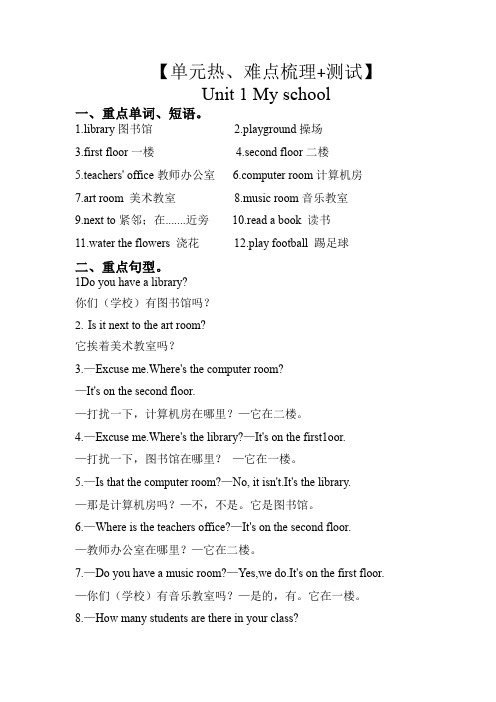
【单元热、难点梳理+测试】Unit 1 My school一、重点单词、短语。
1.library图书馆2.playground操场3.first floor一楼4.second floor二楼5.teachers' office教师办公室puter room计算机房7.art room 美术教室8.music room音乐教室9.next to紧邻;在.......近旁10.read a book 读书11.water the flowers 浇花12.play football 踢足球二、重点句型。
1Do you have a library?你们(学校)有图书馆吗?2.Is it next to the art room?它挨着美术教室吗?3.—Excuse me.Where's the computer room?—It's on the second floor.—打扰一下,计算机房在哪里?—它在二楼。
4.—Excuse me.Where's the library?—It's on the first1oor.—打扰一下,图书馆在哪里?—它在一楼。
5.—Is that the computer room?—No, it isn't.It's the library.—那是计算机房吗?—不,不是。
它是图书馆。
6.—Where is the teachers office?—It's on the second floor.—教师办公室在哪里?—它在二楼。
7.—Do you have a music room?—Yes,we do.It's on the first floor.—你们(学校)有音乐教室吗?—是的,有。
它在一楼。
8.—How many students are there in your class?—Forty-five students.—你们班里有多少学生?—四十五名学生。
(完整版)四年级英语小学英语语法及习题
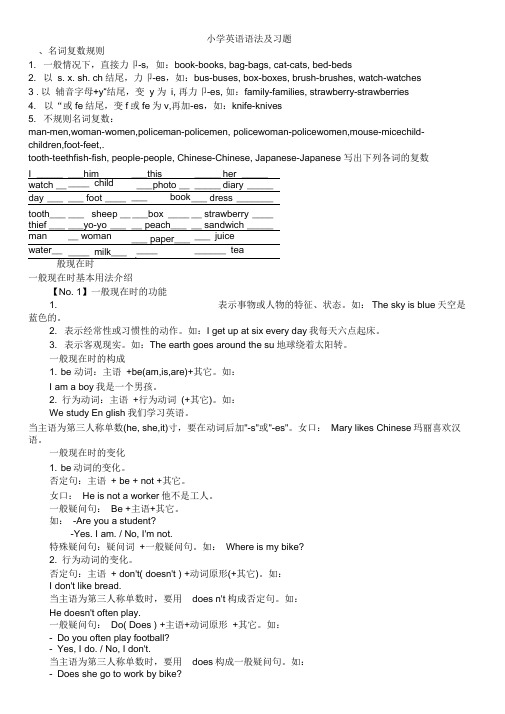
、名词复数规则1. 一般情况下,直接力卩-s, 如:book-books, bag-bags, cat-cats, bed-beds2. 以s. x. sh. ch结尾,力卩-es,如:bus-buses, box-boxes, brush-brushes, watch-watches3 .以辅音字母+y”结尾,变y 为i, 再力卩-es, 如:family-families, strawberry-strawberries4. 以“或fe结尾,变f或fe为v,再加-es,如:knife-knives5. 不规则名词复数:man-men,woman-women,policeman-policemen, policewoman-policewomen,mouse-micechild-children,foot-feet,.tooth-teethfish-fish, people-people, Chinese-Chinese, Japanese-Japanese 写出下列各词的复数般现在时一般现在时基本用法介绍【No. 1】一般现在时的功能1. 表示事物或人物的特征、状态。
如:The sky is blue天空是蓝色的。
2. 表示经常性或习惯性的动作。
如:I get up at six every day我每天六点起床。
3. 表示客观现实。
如:The earth goes around the su地球绕着太阳转。
一般现在时的构成1. be 动词:主语+be(am,is,are)+其它。
如:I am a boy我是一个男孩。
2. 行为动词:主语+行为动词(+其它)。
如:We study En glish我们学习英语。
当主语为第三人称单数(he, she,it)寸,要在动词后加"-s"或"-es"。
女口:Mary likes Chinese玛丽喜欢汉语。
一般现在时的变化1. be动词的变化。
四年级下册第一单元英语知识点及练习题
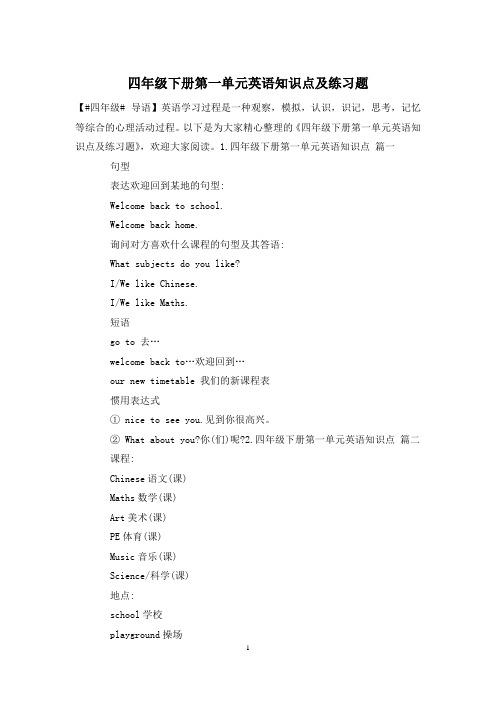
四年级下册第一单元英语知识点及练习题【#四年级# 导语】英语学习过程是一种观察,模拟,认识,识记,思考,记忆等综合的心理活动过程。
以下是为大家精心整理的《四年级下册第一单元英语知识点及练习题》,欢迎大家阅读。
1.四年级下册第一单元英语知识点篇一句型表达欢迎回到某地的句型:Welcome back to school.Welcome back home.询问对方喜欢什么课程的句型及其答语:What subjects do you like?I/We like Chinese.I/We like Maths.短语go to 去…welcome back to…欢迎回到…our new timetable 我们的新课程表惯用表达式① nice to see you.见到你很高兴。
② What about you?你(们)呢?2.四年级下册第一单元英语知识点篇二课程:Chinese语文(课)Maths数学(课)Art美术(课)PE体育(课)Music音乐(课)Science/科学(课)地点:school学校playground操场时间:Monday星期一afternoon下午其他:see看见,看到fun乐趣,快乐subject课程lesson课timetable课程表;时间表3.四年级下册第一单元英语练习题篇三一、连词成句。
1. is Mike Where (? )________________________________________________________________2. is playground That the (. )________________________________________________________________3. is my This classroom (. )________________________________________________________________4. next It’s to art room the (. )________________________________________________________________5. The on library floor is the second (. )________________________________________________________________二、选句子,补全对话。
四年级下册英语第一单元语法点
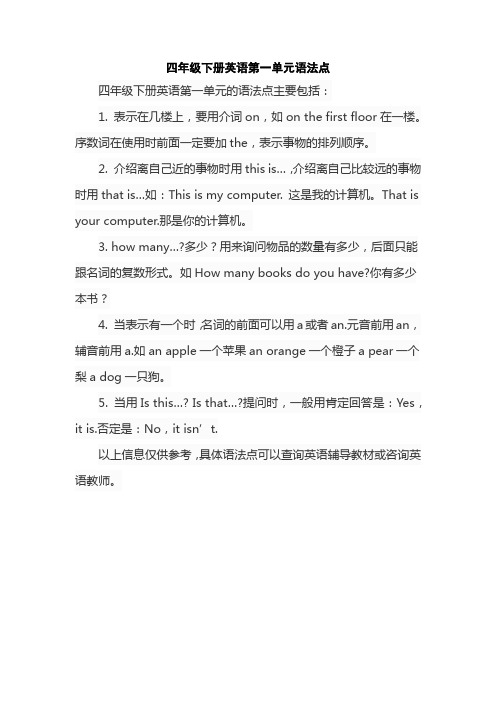
四年级下册英语第一单元语法点
四年级下册英语第一单元的语法点主要包括:
1. 表示在几楼上,要用介词on,如on the first floor在一楼。
序数词在使用时前面一定要加the,表示事物的排列顺序。
2. 介绍离自己近的事物时用this is…,介绍离自己比较远的事物时用that is…如:This is my computer. 这是我的计算机。
That is your computer.那是你的计算机。
3. how many…?多少?用来询问物品的数量有多少,后面只能跟名词的复数形式。
如How many books do you have?你有多少本书?
4. 当表示有一个时,名词的前面可以用a或者an.元音前用an,辅音前用a.如an apple一个苹果an orange一个橙子a pear一个梨a dog一只狗。
5. 当用Is this…? Is that…?提问时,一般用肯定回答是:Yes,it is.否定是:No,it isn’t.
以上信息仅供参考,具体语法点可以查询英语辅导教材或咨询英语教师。
小学四下Unit1知识点归类卷-默写
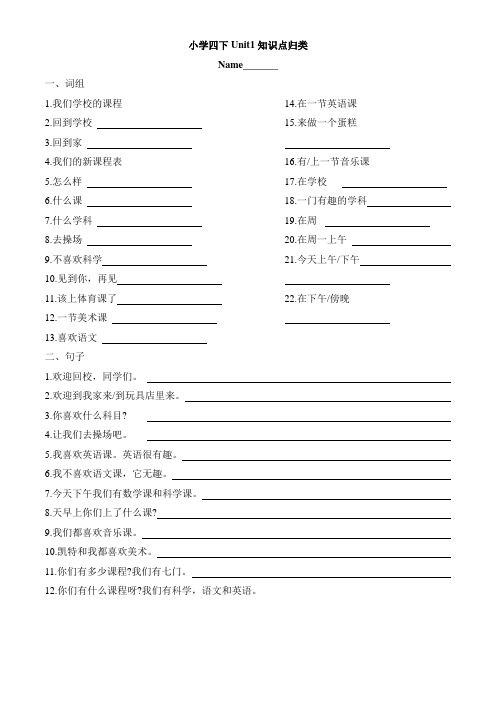
小学四下Unit1知识点归类
Name_______
一、词组
1.我们学校的课程14.在一节英语课
2.回到学校15.来做一个蛋糕
3.回到家
4.我们的新课程表16.有/上一节音乐课
5.怎么样17.在学校
6.什么课18.一门有趣的学科
7.什么学科19.在周
8.去操场20.在周一上午
9.不喜欢科学21.今天上午/下午
10.见到你,再见
11.该上体育课了22.在下午/傍晚
12.一节美术课
13.喜欢语文
二、句子
1.欢迎回校,同学们。
2.欢迎到我家来/到玩具店里来。
3.你喜欢什么科目?
4.让我们去操场吧。
5.我喜欢英语课。
英语很有趣。
6.我不喜欢语文课,它无趣。
7.今天下午我们有数学课和科学课。
8.天早上你们上了什么课?
9.我们都喜欢音乐课。
10.凯特和我都喜欢美术。
11.你们有多少课程?我们有七门。
12.你们有什么课程呀?我们有科学,语文和英语。
【四年级】重大版英语四年级下册Unit1Whereismypencilbox
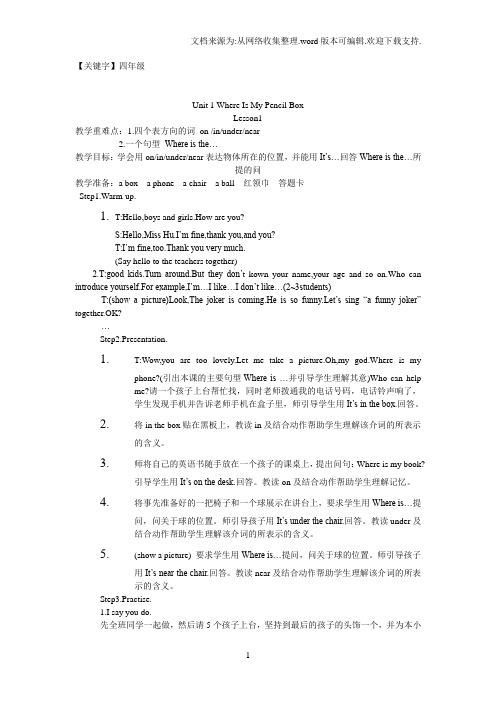
【关键字】四年级Unit 1 Where Is My Pencil BoxLesson1教学重难点:1.四个表方向的词on /in/under/near2.一个句型Where is the…教学目标:学会用on/in/under/near表达物体所在的位置,并能用It’s…回答Where is the…所提的问教学准备:a box a phone a chair a ball 红领巾答题卡Step1.Warm-up.1.T:Hello,boys and girls.How are you?S:Hello,Miss Hu.I’m fine,thank you,and you?T:I’m fine,too.Thank you very much.(Say hello to the teachers together)2.T:good kids.Turn around.But they don’t kown your name,your age and so on.Who can introduce yourself.For example,I’m…I like…I don’t like…(2~3students)T:(show a picture)Look,The joker is coming.He is so funny.Let’s sing “a funny joker” together.OK?…Step2.Presentation.1.T:Wow,you are too lovely.Let me take a picture.Oh,my god.Where is myphone?(引出本课的主要句型Where is …并引导学生理解其意)Who can helpme?请一个孩子上台帮忙找,同时老师拨通我的电话号码,电话铃声响了,学生发现手机并告诉老师手机在盒子里,师引导学生用It’s in the box.回答。
- 1、下载文档前请自行甄别文档内容的完整性,平台不提供额外的编辑、内容补充、找答案等附加服务。
- 2、"仅部分预览"的文档,不可在线预览部分如存在完整性等问题,可反馈申请退款(可完整预览的文档不适用该条件!)。
- 3、如文档侵犯您的权益,请联系客服反馈,我们会尽快为您处理(人工客服工作时间:9:00-18:30)。
There be 句型归纳与练习
1.定义:There be句型表示某处存在某物或某人。
2.结构:
(1) There is +主语(单数可数名词/不可数名词)+ 某地(地点状语).
(2) There are +主语(复数名词)+某地(地点状语).
句子的主语是某人或某物,谓语动词be要与主语(某人或某物)的数保持一致。
当主语是两个或两个以上的名词时,谓语动词要与跟它最近的那个名词一致。
eg. ①There is a bird in the tree. 树上有一只鸟。
②There is a teacher and many students in our classroom. 我们教室里有一位老师和许多学生。
③There are two boys and a girl under the tree. 树下有两个男孩,一个女孩。
④There are a girl and two boys under the tree. 树下有一个女孩,两个男孩。
⑤There are two men in the office. 办公室里有两个男人。
句型变换:否定句
There be句型的否定式的构成和含有be动词的其它句型一样,在be后加上not即可。
例如:
There are some pictures on the wall. →There aren't any
pictures on the wall. There is a bike behind the tree. →There isn't a bike behind the tree.
句型变换:一般疑问句
There be句型的一般疑问句变化是把be动词调整到句首,再在句尾加上问号即可,此为"调整法"。
但同时要注意:当肯定句中有some时,要将其改为any(否定变化也一样)。
看看下面两句:
There is some water on Mars. →Is there any water on Mars? There are some fish in the water. →Are there any fish in the water?
句型变换:特殊疑问句
There be句型的特殊疑问句形式有以下三种变化:
①对主语提问:当主语是人时,用"Who's+介词短语?";当主语是物时,用"What's + 地点\介词短语?"。
注意:无论原句的主语是单数还是复数,对之提问时一般都用be的单数形式(回答时却要根据实际情况来决定)。
如:
There are many things over there. →What's over there? There is a little girl in the room. →Who is in the room?
②对地点状语提问:提问地点当然用"Where is / are+主语?\"啦!例如:
There is a computer on the desk. →Where is the computer? There are four children on the playground. →Where are the
four children?
③对数量提问:一般有两种句型结构:
How many+复数名词+are there+介词短语(某地)?
How much+不可数名词+is there+介词短语(某地)?There be 句型专练
一.根据所给汉语完成句子。
1. 桌子上有一本书和两支钢笔。
There _____ a book and two pens on the desk.
2. 钱包里有些钱。
There ____ some money in the picture.
3. 在吉姆的书包里有一些卡片。
____ _____ some cards in Jim’s bag.
4. 里面还有其他的东西吗?
_____ _____ anything else in it?
5. 我们学校有许多班。
There _____ many _____ in our school.
6. 树上没有鸟。
There _____ ______ birds in the tree.
二.选择填空:
1. Are there any maps on the wall? ___
A. There are some.
B. Yes, there is.
C. Yes, there is one.
D. No, there are.
2. How many ____ are there in the picture?
A. woman
B. women
C. buy
D. milk
3. There aren’t ___ trees near the house. There is only one.
A. any
B. some
C. many
D. much
4. There ___ two bowls of rice on the table.
A. is
B. have
C. has
D. are
5. Are there ___ houses near the river? Yes, there are___.
A. some, some
B. any, some
C. any, any
D. some, any
三.句型转换(将单数句子变成复数,复数变单数):
1. There is a woman near the house.
2. There are some buses near the hill.
3. There are some apples in the tree.
4. There are some oranges in the glass.
5. Is there a baby in the room?
6. There are many beautiful flowers in the garden.
7. There is a bookcase in my study(书房).
8. There is a soccer ball and a basketball on the floor.
9. My new dress is in the wardrobe.
10. There are some big trees behind my house.
11. There are some books on the desk.
12. There are knives in the room.
13. There are some flowers and a desk in the room.。
